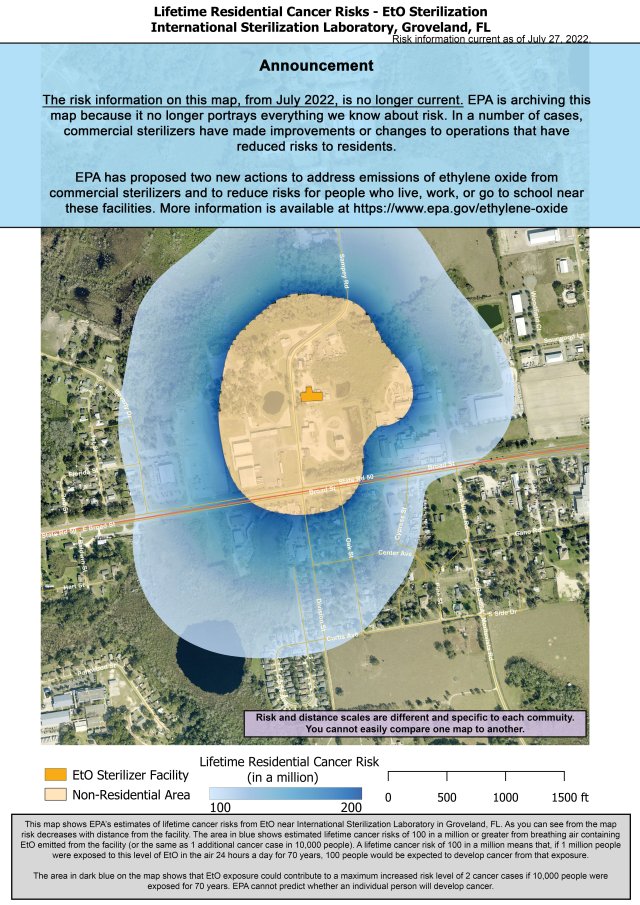Groveland, Florida (International Sterilization Laboratory)
International Sterilization Laboratory is located at 217 Sampey Road, Groveland, FL. The facility uses ethylene oxide (EtO) to sterilize medical equipment and materials.
EPA scientists and analysts recently completed a risk assessment to understand the impact of EtO emissions from the International Sterilization Laboratory facility. As part of this risk assessment, we used the most recent available information about how much EtO the company emits into the air and we modeled estimated cancer risks to people living nearby. The risk assessment identified elevated cancer risk in the Groveland community. EPA is committed to working with state and local agencies, facilities, and communities to reduce this risk.
International Sterilization Laboratory
This map shows EPA’s estimates of lifetime cancer risks from EtO near International Sterilization Laboratory in Groveland, FL. As you can see from the map risk decreases with distance from the facility.
The area in blue shows estimated lifetime cancer risks of 100 in a million or greater from breathing air containing EtO emitted from the facility (or the same as 1 additional cancer case in 10,000 people). A lifetime cancer risk of 100 in a million means that, if 1 million people were exposed to this level of EtO in the air 24 hours a day for 70 years, 100 people would be expected to develop cancer from that exposure.
The area in dark blue on the map shows that EtO exposure could contribute to a maximum increased risk level of 2 cancer cases if 10,000 people were exposed for 70 years (or 200 in 1 million). EPA cannot predict whether an individual person will develop cancer.
View a larger version of the map and legend in a new browser tab.
For this risk assessment, we looked at excess cancer risk attributable to a single chemical, EtO. This estimated risk is in addition to the risk of developing cancer from other causes. This is a worst-case scenario that assumes a person stays in the highest risk area 24 hours a day continuously for 70 years. EPA takes this approach because we want to be protective of the most exposed and most vulnerable individuals from risk associated with EtO emissions from this facility.
Community Details
International Sterilization Laboratory is located near central Florida in Lake County. The facility began operations in the 1990s and is a contract sterilizer of medical equipment. The facility is equipped with wet scrubbers to remove EtO from its sterilization chambers and aeration rooms exhaust. The facility is evaluating plans to reduce the amount of EtO needed for certain sterilization cycles. There has been no recent expansion of control equipment, but the facility is evaluating how to improve its operations to control fugitive emissions.
What EPA is Doing to Address Ethylene Oxide
Now: EPA finalized regulations for Ethylene Oxide Commercial Sterilizers that will significantly lower risk in the community. EPA is also working with the state of Florida to reduce emissions at International Sterilization Laboratory. EPA has provided technical support to our air agency partners as part of this work. The Agency is reviewing controls on regulated equipment and processes that emit EtO to determine whether additional air pollution controls are needed. This review includes examining new developments in practices, processes and control technologies, considering cost and feasibility, as well as addressing any previously unregulated emission points.
- Learn more about the final rule for EtO Sterilization Facilities.
- For more information about actions you can take.
- View the Ethylene Oxide Emissions Information for Residents - International Sterilization Laboratory October 2022 Fact Sheet (pdf)
Contact EPA Region 4 at Region4EtO@epa.gov or 1-800-241-1754.
Community Meeting
A virtual community meeting was held December 15, 2022. View the video here.

